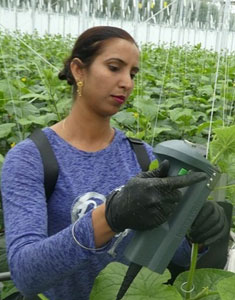Sign up here to subscribe to the Grower2grower Ezine. Every two weeks you will receive new articles, specific to the protected cropping industry, informing you of industry news and events straight to your inbox.
Apr 2024
A crop on the cusp of ruin by leaf mould and the return of psyllid yellows.

As autumn approaches growers face a different set of problems that require different solutions.
Psyllids (TPP):
In the past week, I’ve seen a badly infected plant, within a tomato crop, with Candidatus Liberibacter transmitted by tomato/potato psyllid (TPP). I was not shocked but a little disappointed as it is the first infected plant I have seen this year. For the past two years, particularly in the South Auckland region, we have had regular summer rain, both the Hunua (73.7%) and Waitakere (86%) damns have good reserves and on average are 2.09% above the historical average (Date 23/4/2024 https://aucklandwatersupply.co.nz) The last time we had a long dry spell in 2022 I saw a lot more infection.
The questions are why the level of psyllids appear to be lowered this year and why I am seeing less Candidatus Liberibacter:
- Are outdoor psyllid populations influenced by weather conditions?
- Are predators introduced via IPM programmes working effectively or are natural enemy populations of the psyllid more prolific?
- Have the percentage of psyllids carrying the Candidatus Liberibacter decreased?
Whatever the reason, the sighting this week is a good reminder not to rest on our laurels.

Above image – plant infected with Candidatus Liberibacter.
Leaf Mould:
Tomato leaf mould (Cladosporium), is another issue facing growers. I am finding it increasingly difficult to control, once it is in a crop it never leaves. It does unfortunately require intervention via spraying.
If you are severely infected, de-leaf one to two leaves higher than normal, remove all the removed leaf from the greenhouse and spray the remaining leaf area as soon as possible. Yes – this will affect production, any radical action does.
If you only have a minor infection, don’t procrastinate, contact your local Horticentre or Tasman Crop rep today for preventive options.
If your property is struggling with leaf mould discuss it with your seed company. New strains of leaf mould may mean that some varieties with resistance may need replacing.

Above image, conditions are ideal for rapid reproduction of leaf mould.
See additional information below: Source Copilot.
Tomato leaf mold, caused by the fungal pathogen Passalora fulva (previously known as Cladosporium fulvum), is a destructive foliar disease affecting tomatoes, especially in humid conditions. Let’s delve into the details:
- Cause and Identification:
- Cause: Tomato leaf mould is primarily caused by Passalora fulva, which is an ascomycete fungus.
- Identification: Identifying specific strains of this pathogen is challenging. The fungus produces conidia (spores) that can infect tomato leaves. It has been found both on and within tomato seeds, indicating potential seedborne infection. These spores are highly resistant to dry conditions and low temperatures, surviving from one crop to the next. Additionally, the pathogen can persist on dried leaf debris1.
- Environmental Factors and Symptoms:
- Humidity: High relative humidities (above 85%) are critical for spore germination and fungal hyphae penetration through stomata.
- Temperature: Warm temperatures (22–24°C) combined with high humidity can lead to epidemics. However, even at temperatures as low as 4°C, the disease can still develop, albeit slowly.
- Symptoms: Leaf mould typically appears as yellowish spots on the upper leaf surface. Advanced stages reveal velvety fungal hyphae exiting from stomata on the lower leaf surface, forming a brown mould. Spores are easily spread by air currents, insects, and human contact1.
If you’re dealing with tomato leaf mould, consider implementing preventive measures such as proper sanitation, selecting resistant varieties, and managing environmental conditions to minimize its impact on your tomato plants.
See previous Grower2Grower articles written regarding psyllid and leaf mould.
Psyllid Yellow’s – Grower2Grower
Leaf Mould – Cladosporium – Grower2Grower

CLASSIFIED
Photo
Gallery
Subscribe to our E-Zine
More
From This Category

No Shortcuts in CEA: Hard Truths on Greenhouse Success
Den Berk Délice improved production predictability and energy efficiency with Philips horticulture intelligent lighting
Intelligent Philips LED lighting at J&A Chrysanten optimizes production and energy efficiency

A holistic approach in a full LED tomato trial resulted in a 50% reduction in heat input
AP4 Porometer by Delta-T Devices


























































